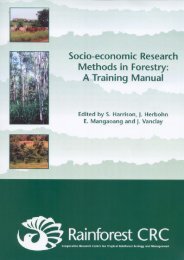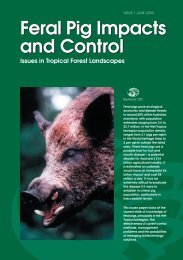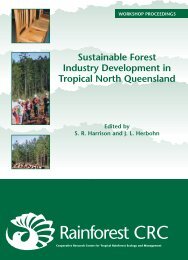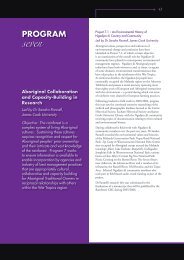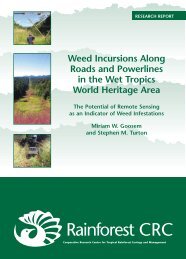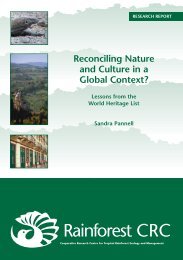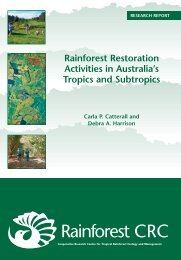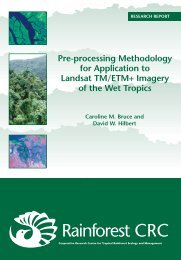Reconciling Nature and Culture in a Global Context? - Rainforest ...
Reconciling Nature and Culture in a Global Context? - Rainforest ...
Reconciling Nature and Culture in a Global Context? - Rainforest ...
You also want an ePaper? Increase the reach of your titles
YUMPU automatically turns print PDFs into web optimized ePapers that Google loves.
S<strong>and</strong>ra PannellAt Suomenl<strong>in</strong>na the erasure of this less picturesque history is materially achieved by therestoration of the fortress complex itself. Ongo<strong>in</strong>g restoration work at the fortress isundertaken to satisfy the authenticity <strong>and</strong> <strong>in</strong>tegrity requirements of the World HeritageConvention. As stated <strong>in</strong> the Convention’s operational guidel<strong>in</strong>es, the “physical fabric” ofproperties nom<strong>in</strong>ated under the ‘cultural’ criteria (i) to (vi), “should be <strong>in</strong> good condition, <strong>and</strong>the impact of deterioration processes controlled” (UNESCO 2005: 22). At Suomenl<strong>in</strong>narestor<strong>in</strong>g the fortifications <strong>in</strong> keep<strong>in</strong>g with their current status as “monument, a culturalcentre, a borough <strong>and</strong> a tourist attraction” (The Estate of Olof af Hällstrom 2004: 49) haseffectively obliterated the material scars of more than three hundred years of warfare. In thisrespect, the Military Fortress of Suomenl<strong>in</strong>na is not alone. As Uzzell <strong>and</strong> Ballantyne po<strong>in</strong>tout, there are “many museums around the world where the sartorial elegance of the soldiery<strong>and</strong> the impressiveness of the <strong>in</strong>struments of war assumes as much if not more significancethat their purpose <strong>and</strong> effect” (1998: 156-157). In these contexts, like Suomenl<strong>in</strong>na, war isreduced to a simple story about the application of military technology <strong>and</strong> <strong>in</strong>dustrialdevelopments to the slaughter of thous<strong>and</strong>s, if not millions, of people. As Uzzell <strong>and</strong>Ballantyne conclude, “as we go back <strong>in</strong> time we seem to be more will<strong>in</strong>g to ignore suffer<strong>in</strong>g<strong>and</strong> treat events <strong>in</strong> a more dis<strong>in</strong>terested way as if they come from a ‘foreign country’” (1998:157). In part, this social ‘forgett<strong>in</strong>g’ of temporally distant <strong>and</strong> shameful events is driven bythe transformation of sites associated with war <strong>and</strong> conflict from memorials <strong>and</strong> places ofremembrance to tourist attractions <strong>and</strong> day-trip dest<strong>in</strong>ations. However, battlefields,massacres sites, <strong>and</strong> the ground zero of mass destruction events, <strong>in</strong> which unspeakableatrocities, horror <strong>and</strong> tragedy are constitutive elements, do not readily provide visitors with an“enterta<strong>in</strong><strong>in</strong>g day out for all the family” (Uzzell <strong>and</strong> Ballantyne 1998: 165). While ‘darktourism’ is identified as a “grow<strong>in</strong>g phenomenon <strong>in</strong> the late twentieth <strong>and</strong> early twenty-firstcenturies” (Lennon <strong>and</strong> Foley 2000: 3), it is apparent that heritage <strong>in</strong>terpretation at these‘fatal attractions’ often presents “a sanitised form of truth which will not upset, offend orchallenge” (Uzzell <strong>and</strong> Ballantyne 1998: 165). This last po<strong>in</strong>t is particularly evident <strong>in</strong> theway that history is <strong>in</strong>terpreted <strong>and</strong> presented at the Military Fortress of Suomenl<strong>in</strong>na.For all the talk of military engagements, there is little sense of the Suomenl<strong>in</strong>na site as acontested cultural doma<strong>in</strong> <strong>in</strong> a presentation that largely celebrates Swedish <strong>and</strong> Russianmilitary history. Indeed, what is <strong>in</strong>terest<strong>in</strong>g about Suomenl<strong>in</strong>na is the way <strong>in</strong> which themilitary achievements of Sweden <strong>and</strong> Russia, <strong>and</strong> their varied historical occupation of theregion, have not been downplayed or rewritten to opportunistically serve the ends ofcontemporary F<strong>in</strong>nish nationalism. Perhaps, this says someth<strong>in</strong>g about the uncerta<strong>in</strong> <strong>and</strong>unf<strong>in</strong>ished nature of F<strong>in</strong>nish nationalism or about the error of assum<strong>in</strong>g the existence of anethnically <strong>in</strong>dependent <strong>and</strong> historically de-contextualised F<strong>in</strong>nish identity. Unlike the WorldHeritage site of Stonehenge, where there is no doubt about the fact that “it belongs to thenation <strong>and</strong> falls under the guardianship of English Heritage” (van der Aa et al. 2005: 18),Suomenl<strong>in</strong>na, while nom<strong>in</strong>ated by the Government of F<strong>in</strong>l<strong>and</strong>, strongly po<strong>in</strong>ts to its ‘sharedheritage’. And while the World Heritage site of the Tower of London monumentalises therock-solid stability of Engl<strong>and</strong>’s constitutional monarchy, Suomenl<strong>in</strong>na po<strong>in</strong>ts to the ebb <strong>and</strong>flow of power <strong>and</strong> illustrates the rise <strong>and</strong> fall of powerful empires <strong>and</strong> long-reign<strong>in</strong>g k<strong>in</strong>gdoms<strong>in</strong> this part of Europe.The identity of Suomenl<strong>in</strong>na as a pivotal focal po<strong>in</strong>t <strong>in</strong> the histories of at least three Europeannations raises some <strong>in</strong>terest<strong>in</strong>g questions about whose heritage it is, who should protect it,<strong>and</strong> if it is a ‘shared heritage’, to what extent does the Convention recognise multilateralnom<strong>in</strong>ations. As to the question of whose heritage it is <strong>and</strong> who should protect it, the WorldHeritage listed site of the Statue of Liberty <strong>and</strong> the associated immigration museum on EllisIsl<strong>and</strong> provide us with some <strong>in</strong>sights <strong>and</strong> possible answers. This site certa<strong>in</strong>ly representsone of the more iconic World Heritage properties to symbolise a multicultural heritage <strong>and</strong>transnational citizenship. As a site associated with the entry of an estimated twelve millionmigrants <strong>in</strong>to the United States of America, the Statue of Liberty site challenges the moresedentary <strong>and</strong> stable read<strong>in</strong>gs of history associated with so many of the cultural heritage50




